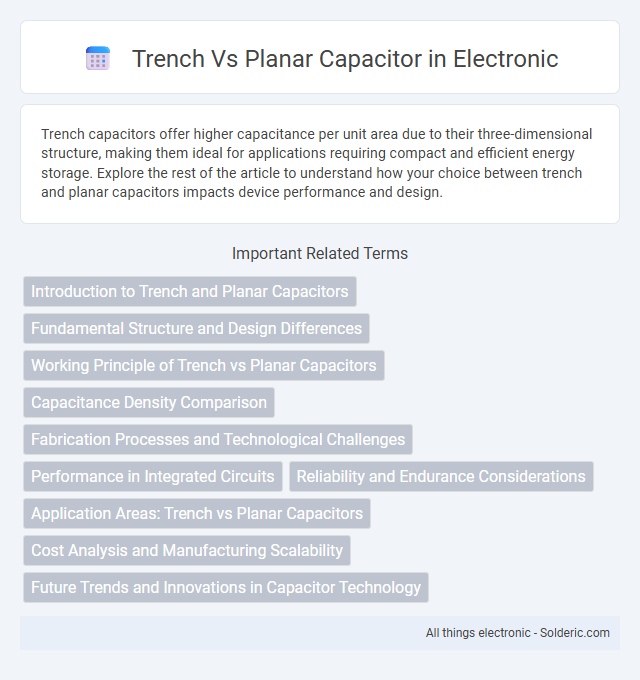Trench capacitors offer higher capacitance per unit area due to their three-dimensional structure, making them ideal for applications requiring compact and efficient energy storage. Explore the rest of the article to understand how your choice between trench and planar capacitors impacts device performance and design.
Comparison Table
| Feature | Trench Capacitor | Planar Capacitor |
|---|---|---|
| Structure | Vertical trench etched into the substrate | Flat, horizontal layers on the substrate surface |
| Capacitance Density | Higher, due to 3D vertical structure | Lower, limited by surface area |
| Size Efficiency | Compact, saves chip area | Larger footprint, less compact |
| Fabrication Complexity | More complex etching and filling processes | Simpler, standard photolithography techniques |
| Applications | High-density memory, DRAM cells | General IC capacitors, analog circuits |
| Voltage Handling | Higher voltage tolerance | Moderate voltage tolerance |
| Parasitic Capacitance | Lower due to vertical isolation | Higher, affected by layout |
Introduction to Trench and Planar Capacitors
Trench capacitors feature a three-dimensional structure with deep vertical trenches etched into the silicon substrate, significantly increasing capacitance per unit area compared to traditional planar capacitors. Planar capacitors, by contrast, consist of flat, layered electrodes on the surface of the substrate, offering a simpler fabrication process but limited capacitance density. Your choice between trench and planar capacitors depends on device size constraints and capacitance requirements in integrated circuits.
Fundamental Structure and Design Differences
Trench capacitors feature a vertical design with deep, narrow trenches etched into the silicon substrate, maximizing surface area within a compact footprint for higher capacitance. Planar capacitors employ a flat, horizontal layout with electrodes arranged side-by-side on the substrate surface, providing simpler fabrication but lower capacitance density. Your choice depends on the application's size constraints and capacitance requirements, with trench capacitors offering enhanced performance in modern integrated circuits.
Working Principle of Trench vs Planar Capacitors
Trench capacitors increase capacitance by utilizing vertical sidewalls etched into the silicon substrate, allowing a larger surface area within a smaller footprint, which enhances charge storage through the increased electrode interface. Planar capacitors rely on flat, horizontal electrode layers separated by a dielectric, limiting their capacitance density due to the two-dimensional surface area constraint. The trench structure exploits three-dimensional geometry to improve capacitance per unit area, making trench capacitors more suitable for high-density integrated circuits.
Capacitance Density Comparison
Trench capacitors offer significantly higher capacitance density compared to planar capacitors due to their vertical structure, which maximizes surface area within a limited footprint. Planar capacitors, with their flat electrode design, provide lower capacitance density limited by the dielectric thickness and lateral dimensions. The use of high-k dielectrics and deep trench etching techniques further enhances the capacitance density achievable in trench capacitors, making them ideal for DRAM applications where space efficiency is critical.
Fabrication Processes and Technological Challenges
Trench capacitors are fabricated using anisotropic etching to create deep, narrow structures followed by doping and dielectric layer deposition, which enables high capacitance in limited surface areas. Planar capacitors involve simpler fabrication with thin film deposition and lithographic patterning on flat substrates but face challenges in scaling capacitance density. Your choice depends on balancing trench capacitor's complexity in etching and filling processes against planar capacitor's limitations in achieving miniaturization and high capacitance.
Performance in Integrated Circuits
Trench capacitors typically offer higher capacitance density and lower parasitic resistance compared to planar capacitors, enhancing performance in integrated circuits where space and efficiency are critical. Their vertical structure reduces area consumption and allows better scalability in advanced semiconductor nodes. Planar capacitors, while simpler to fabricate, often suffer from lower capacitance per unit area and higher leakage currents, limiting their effectiveness in high-performance IC applications.
Reliability and Endurance Considerations
Trench capacitors exhibit superior reliability and endurance due to their vertical structure, which reduces parasitic effects and enhances mechanical stability under high electric fields. Planar capacitors, while simpler to fabricate, often face limitations in endurance as their surface area and dielectric layers are more prone to breakdown and fatigue over prolonged use. Advanced trench capacitor designs mitigate dielectric degradation and improve longevity, making them preferable for high-reliability applications such as DRAM cells and embedded systems.
Application Areas: Trench vs Planar Capacitors
Trench capacitors are widely used in high-density DRAM memory cells due to their superior capacitance per unit area and ability to fit into smaller silicon footprints, making them ideal for advanced semiconductor applications requiring miniaturization. Planar capacitors, on the other hand, find extensive use in analog circuits and power electronics because of their simpler fabrication process and better voltage handling capabilities. Understanding the differences in application areas helps you select the appropriate capacitor type for specific integrated circuit designs, balancing performance and manufacturing complexity.
Cost Analysis and Manufacturing Scalability
Trench capacitors typically involve higher manufacturing costs due to complex deep etching and doping processes, whereas planar capacitors offer cost-effective production through established lithography techniques. The scalability of planar capacitors aligns with standard CMOS fabrication, enabling mass production and integration with minimal expense. Your choice between trench and planar capacitors should consider the trade-off between performance benefits and manufacturing economics for large-scale deployment.
Future Trends and Innovations in Capacitor Technology
Trench capacitors offer superior capacitance density and miniaturization advantages compared to planar capacitors, making them ideal for future high-performance and compact memory devices. Innovations focus on enhancing trench fabrication techniques and integrating novel dielectric materials to boost energy efficiency and reliability. Your next-generation electronic designs will benefit from these advances as trench capacitors continue evolving to meet the demands of faster, smaller, and more power-efficient technologies.
Trench vs Planar capacitor Infographic

 solderic.com
solderic.com